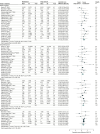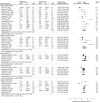Associations of Multidomain Interventions With Improvements in Cognition in Mild Cognitive Impairment: A Systematic Review and Meta-analysis
- PMID: 35503222
- PMCID: PMC9066287
- DOI: 10.1001/jamanetworkopen.2022.6744
Associations of Multidomain Interventions With Improvements in Cognition in Mild Cognitive Impairment: A Systematic Review and Meta-analysis
Erratum in
- doi: 10.1001/jamanetworkopen.2025.0896
Abstract
Importance: Older adults with mild cognitive impairment (MCI) have the highest risk of progressing to dementia. Evidence suggests that nonpharmacological, single-domain interventions can prevent or delay progressive declines, but it is unclear whether greater cognitive benefits arise from multidomain interventions.
Objective: To determine whether multidomain interventions, composed of 2 or more interventions, are associated with greater improvements in cognition among older adults with MCI than a single intervention on its own.
Data sources: MEDLINE, Embase, PsycInfo, AgeLine, CINAHL, and Cochrane Central Register of Controlled Trials were systematically searched from database inception to December 20, 2021.
Study selection: Included studies contained (1) an MCI diagnosis; (2) nonpharmacological, multidomain interventions that were compared with a single active control; (3) older adults aged 65 years and older; and (4) randomized clinical trials.
Data extraction and synthesis: Data were screened and extracted by 3 independent reviewers. Following Preferred Reporting Items for Systematic Reviews and Meta-analyses (PRISMA) guidelines, random-effects meta-analyses were used to calculate effect sizes from the standardized mean difference (SMD) and 95% CIs.
Main outcomes and measures: Postintervention cognitive test scores in 7 cognitive domains were compared between single-domain and multidomain groups. Exposure to the intervention was analyzed.
Results: A total of 28 studies published between 2011 and 2021, including 2711 older adults with MCI, reported greater effect sizes in the multidomain group for global cognition (SMD, 0.41; 95% CI, 0.23-0.59; P < .001), executive function (SMD, 0.20; 95% CI, 0.04-0.36; P = .01), memory (SMD, 0.29; 95% CI, 0.14-0.45; P < .001), and verbal fluency (SMD, 0.30; 95% CI, 0.12-0.49; P = .001). The Mini-Mental State Examination (SMD, 0.40; 95% CI, 0.17-0.64; P < .001), category verbal fluency test (SMD, 0.34; 95% CI, 0.13-0.56; P = .002), Trail Making Test-B (SMD, 0.46; 95% CI, 0.13-0.80; P = .007), and Wechsler Memory Scale-Logical Memory I (SMD, 0.47; 95% CI, 0.15-0.80; P < .001) and II (SMD, 0.26; 95% CI, 0.07-0.45; P < .001) favored the multidomain group. Exposure to the intervention varied between studies: the mean (SD) duration was 71.3 (36.0) minutes for 19.8 (14.6) weeks with sessions taking place 2.5 (1.1) times per week, and all interventions lasted less than 1 year.
Conclusions and relevance: In this study, short-term multidomain interventions (<1 year) were associated with improvements in global cognition, executive function, memory, and verbal fluency compared with single interventions in older adults with MCI.
Conflict of interest statement
Figures



References
-
- Petersen RC, Lopez O, Armstrong MJ, et al. . Practice guideline update summary: mild cognitive impairment: report of the Guideline Development, Dissemination, and Implementation Subcommittee of the American Academy of Neurology. Neurology. 2018;90(3):126-135. doi:10.1212/WNL.0000000000004826 - DOI - PMC - PubMed
Publication types
MeSH terms
Grants and funding
LinkOut - more resources
Full Text Sources
Medical

